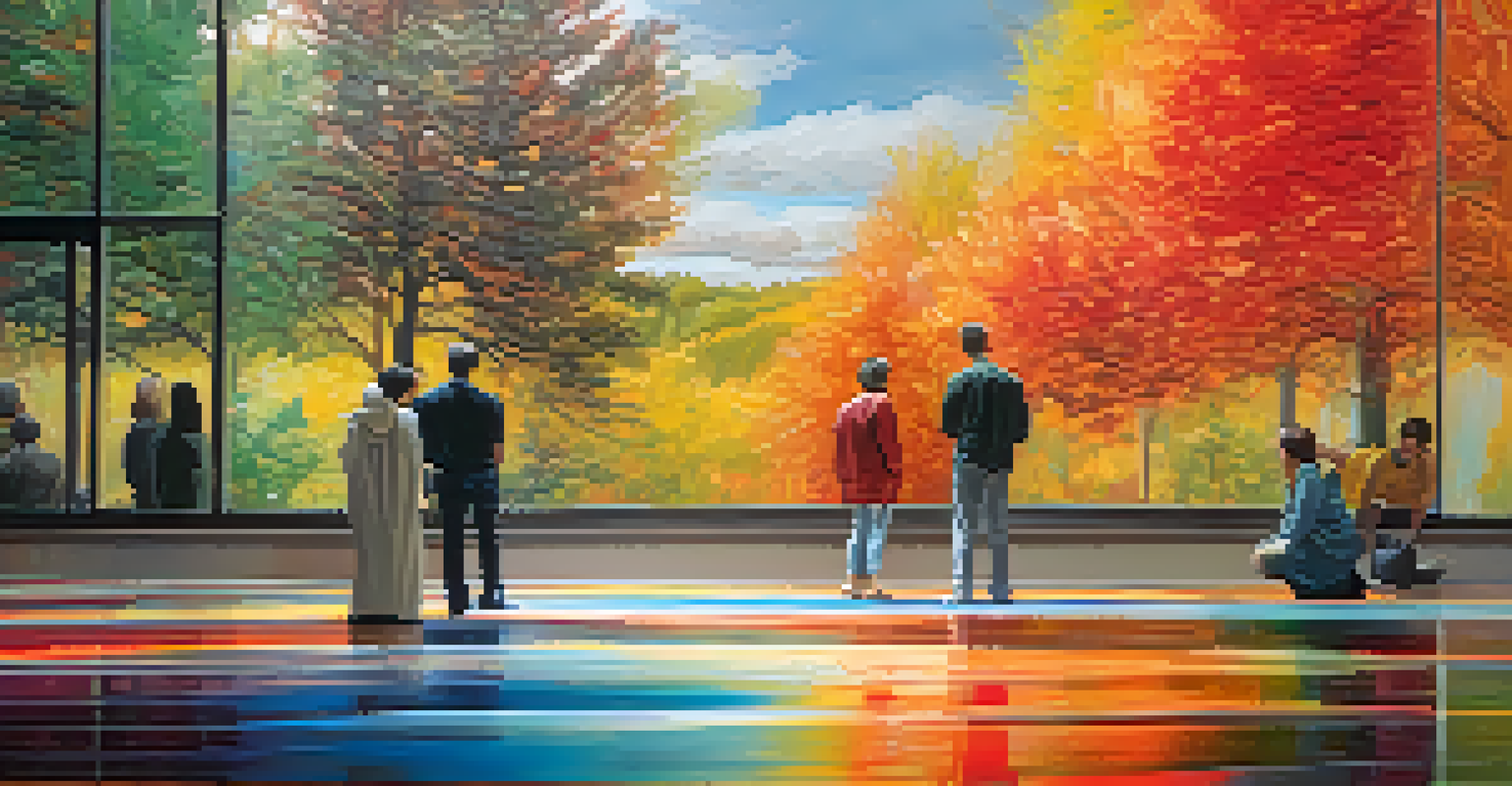The Importance of Art Critique in the Painting Process Today

Understanding Art Critique and Its Purpose
Art critique is a thoughtful analysis of an artwork, aimed at understanding its meaning and value. It serves as a bridge between the artist’s intentions and the audience’s perception, allowing for valuable feedback. By dissecting various elements such as composition, color, and technique, critique encourages deeper appreciation and engagement with the art.
Every artist dips his brush in his own soul, and paints his own nature into his pictures.
This process isn’t just about pointing out flaws; it’s an exploration of strengths and areas for growth. Critique fosters a dialogue that can significantly impact an artist's development, helping them refine their skills and broaden their perspective. Ultimately, it offers insights that can elevate their work to a new level.
In today’s fast-paced digital age, where art can quickly be shared and critiqued online, understanding this process is more crucial than ever. Artists can benefit from the diverse viewpoints offered, which can challenge their understanding and push them toward innovation.
The Evolution of Art Critique in the Digital Age
With the rise of social media and online galleries, art critique has transformed into a more accessible and communal experience. Artists can receive immediate feedback from a global audience, which can be both exhilarating and daunting. This shift has democratized the critique process, allowing voices from all walks of life to contribute.

However, this accessibility comes with its own set of challenges. The sheer volume of feedback can be overwhelming, and not all critiques are constructive. Artists must learn to navigate this digital landscape, discerning valuable insights from the noise.
Art Critique Fuels Artistic Growth
Engaging in critique provides artists with valuable feedback that helps identify strengths and areas for improvement.
Moreover, the fast-paced nature of online critique often emphasizes quick judgments over thoughtful analysis. This can lead to superficial evaluations that may not adequately serve the artist’s growth. Striking a balance between immediate feedback and thorough critique is essential for nurturing creativity.
How Art Critique Enhances Artistic Growth
Critique plays a vital role in an artist’s journey by providing diverse perspectives. When artists receive feedback, they can identify patterns in their work and recognize areas that need improvement. This process of reflection is crucial for continuous growth and development.
Art is not freedom from discipline, but disciplined freedom.
For instance, an artist might learn that their use of color resonates well but their composition feels disjointed. Such insights can guide them to experiment and explore new techniques, pushing the boundaries of their creativity. In this way, critique serves as a catalyst for innovation.
Additionally, constructive criticism can boost an artist's confidence. Knowing that others see potential in their work motivates them to explore uncharted territories, ultimately leading to more authentic expressions of their artistic voice.
The Role of Community in Art Critique
Art critique thrives in community settings, where artists can engage with peers and mentors. These interactions create a supportive environment that fosters open dialogue and encourages experimentation. In such spaces, artists feel safe to share their vulnerabilities and seek guidance.
Community critique can take many forms, from formal workshops to informal studio visits. Each scenario offers unique opportunities for growth and reflection. By exchanging ideas and discussing different viewpoints, artists can broaden their understanding of their work and the broader art world.
Community Enhances Critique Process
Participating in critique within a community fosters a supportive environment that encourages experimentation and open dialogue.
Moreover, the sense of belonging that comes from participating in a critique group can be incredibly empowering. Artists often find inspiration from one another, sparking new ideas that they might not have discovered on their own.
Navigating Feedback: Constructive vs. Destructive Critique
Not all feedback is created equal; understanding the difference between constructive and destructive critique is essential. Constructive critiques focus on helping the artist improve, offering specific suggestions and insights. In contrast, destructive feedback can be hurtful and unhelpful, often leaving artists feeling discouraged.
It’s important for artists to cultivate resilience and learn to filter feedback. Embracing constructive criticism while setting boundaries against negativity helps maintain motivation and creativity. Engaging with feedback can be a rewarding experience when approached with an open mind.
One way to navigate this landscape is by asking for specific types of feedback. Artists might request opinions on particular elements of their work, which can lead to more focused and helpful critique. This proactive approach empowers artists to take charge of their artistic journey.
The Importance of Art Critique in Education
In educational settings, art critique is fundamental to teaching and learning. It provides students with the opportunity to articulate their thoughts and engage in meaningful discussions about their work and others'. This process not only enhances their critical thinking skills but also fosters a sense of community among peers.
Educational critique often emphasizes the importance of both giving and receiving feedback. Students learn to appreciate different perspectives and develop the ability to express their thoughts thoughtfully. This skill set is invaluable, as it prepares them for professional artistic environments.
Navigating Feedback for Improvement
Understanding the difference between constructive and destructive critique empowers artists to focus on valuable insights while maintaining motivation.
Furthermore, art critique in education helps establish a culture of continuous improvement. Students are encouraged to experiment, take risks, and learn from their mistakes, all while receiving guidance from instructors and peers. This nurturing environment can significantly influence their artistic evolution.
Embracing Vulnerability through Art Critique
Engaging in critique requires a certain level of vulnerability, as artists expose their creations to scrutiny. This openness can be intimidating, but it also creates opportunities for profound growth. By allowing others to see their work, artists invite fresh perspectives that can enrich their practice.
Vulnerability in art critique can lead to unexpected breakthroughs. For instance, an artist might discover that a piece they felt unsure about resonates deeply with others, encouraging them to explore that style further. Embracing this vulnerability invites authenticity and fosters deeper connections with their audience.

Ultimately, art critique is not just about assessing quality; it’s about building relationships and understanding. Through vulnerability, artists can engage in meaningful conversations that enhance their work and cultivate a shared appreciation for the creative process.